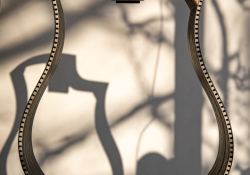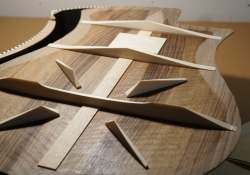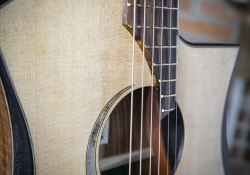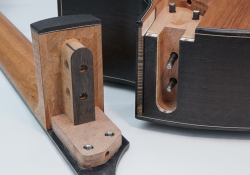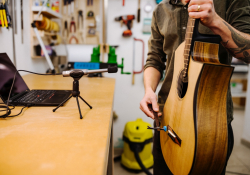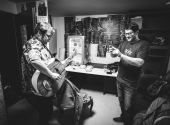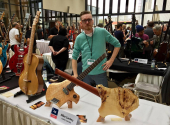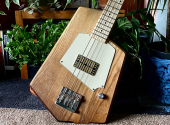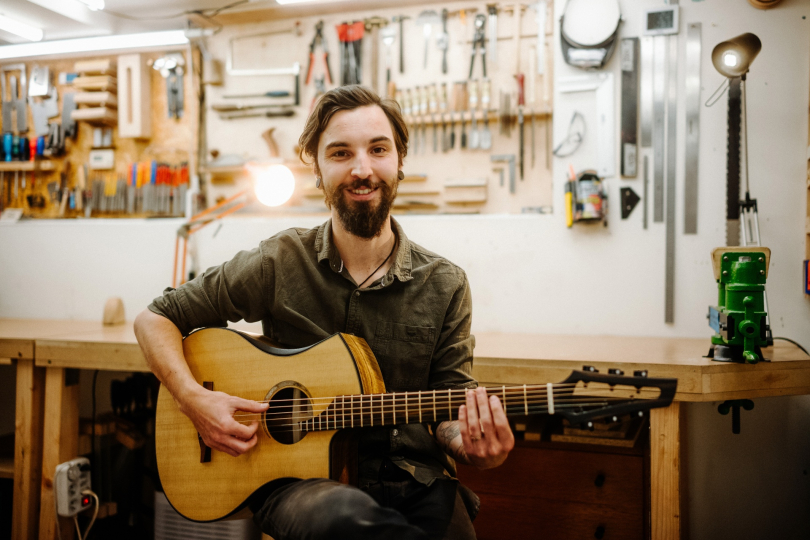
Dreamstruments #24: Salz Guitars
Today's globally connected age is no longer about difficult information retrieval as it used to be. It's much more about selecting, organizing and using it in practice. Young progressive guitar maker David Mák is proof of how a world-class level can be achieved with astonishing speed with this approach. So let's take a look at the modern dreamstruments of Salz guitars.
I have come across his impressive and visually polished work earlier on the biggest acoustic forum and I had no idea that he was such a young compatriot. David's path to acoustic guitars has been a rather convoluted one. Originally a bass player, after a science grammar school and a semester at the Faculty of Tropical AgriSciences, he tried various sources of livelihood from bartender to roadie. Gradually, however, he became more and more attracted to working with his hands, and despite ultimately unrealized plans for carpentry, the possibility of studying musical instrument-making suddenly came up.
So he started studying in Hradec Králové with the idea of building a cool headless bass guitar and, actually, picked up a rasp or planer for the first time. He wasn't too keen on the acoustic guitar project he was assigned to do until he pulled a string and strummed it for the first time. That's when the boring work took on a higher purpose, and a thing was created that not only could be touched (it was real and existed) but also could give joy. This unexpected moment of initiation literally opened up a whole new world for him, and David began to devour all the available materials for building acoustic guitars.
Thanks to his knowledge of English he was able to draw on the most up-to-date knowledge and thanks to the surprising openness, selfless sharing of information and help of world luthiers, he quickly found his own modern way without being unnecessarily bound by tradition. Guitar making has been undergoing a rapid and explosive development in the last few decades and the previously unshakable opinion that the best acoustic guitar is the so-called pre-war Martin is no longer valid.
More precisely, it depends on the person. Hardened traditionalists may disagree but modern guitarists relentlessly pushing the boundaries of technique, playability and sonic context into previously hard-to-believe dimensions obviously need adequate instruments to do so.
David has been inspired by world stars such as Bashkin, Murraykuun, Matsuda and Casimi. He has also found another rich source in Trevor Gore's excellent book on contemporary guitar making with a scientific twist. His workshop is constantly playing the Fretboard Journal podcasts and let's not forget Instagram! So David has gradually transmuted this raw matter into his alchemically personal project Salz Guitars.
Salz Guitar #15
The Salz logo is in fact not only an old alchemist's mark for salt but also David's expression of respect for his ancestors, whose name of Salz has faded in the family line. The SALZ stamp appears beautifully on a guitar label made from recycled paper made by David's wife.
This small, comfortable, approximately parlour or 00 of the most classic materials (European spruce, Indian rosewood, Honduran mahogany) already fully accentuates the carefully laid out concept of Salz guitars. It has a luxurious perforated headstock with straight string placement (more advantageous for tuning stability) and a low angle to the neck, as the lower mechanics ensure sufficient string pitch behind the zero fret. The all-bolted neck has spontaneously replaced other neck-body joint designs for its advantages with most boutique manufacturers.
The so-called structured sides, with their exceptional stiffness, allow the front and back plates to be effectively activated with special composite bracing made of wood with carbon fibre. The uncompromising line of the cutaway and the unconventional upper sharp corner gently evoke the now-forgotten acoustic guitar of legendary innovator Ken Parker. It is, in short, the ideal instrument for the contemporary fingerstyle guitarist.
Salz Guitar #16
As part of his "Salz Manifesto", David also made a sibling – the same guitar but in a different wood. The top is Sitka spruce, the back is European walnut. The textured walnut and basswood sides are complemented by an inner layer of black swamp oak from the Charles Bridge. The neck is made of ebonized cedar.
The textured sides are complemented by bevels on all four edges, which, in addition to comfort, greatly increases their rigidity and makes the soundboard free. This construction is beautifully explained by the analogy of Dutch weirs, where the soft sandy edges absorb the energy of water waves. In contrast, weirs with hard banks visibly reflect the wave energy back, and therefore the stiffer sides contribute to the sound quality of the instrument and do not take energy away from the soundboard.
The model has the beautiful curves of the so-called Falcate composite bracing, a soundport for improved player comfort, straight string placement at the headstock, a carbon fibre reinforced bridge pad to make it both strong and light, a bolt-on neck allowing complete disassembly in minutes, brass binding, a moon crescent shaped rosette, and a special epoxy and oil finish by Ken Parker.
Are you hesitating about which one to choose? I've recorded some demos under the same conditions that may be of some help with this Sophie's choice.
Salz Guitar #11
These are not unique Salz siblings, however. Earlier, David wanted to test the effect of back and sides material – to see how medium-density maple would perform against high-density ebony. These twins have a Swiss moon spruce top and a wenge neck with fretboard, back and sides made from figured maple or sustainably harvested flamed ebony.
The Maple #11 was chosen by Mirek Vlasák (Epydemye) an extremely demanding customer who showed David a new dimension of aural judgement – after careful playing, for example, he commented that when he struck an A minor chord, the instrument began to "howl" slightly. David thus verified in live practice Trevor Gore's 'tap testing', whereby tapping with a recording microphone produces a frequency image of the instrument or plate. And he saw that the guitar did indeed pick up more resonance at a certain frequency (the so-called wolf tone).
Fortunately, even this can be corrected with a good knowledge of the frequency properties by removing braces on the back plate or adding mass to the front plate, so Mirek Vlasák (Epydemye) was finally satisfied. Incidentally, the video showing this measurement was very successful on Salz's Instagram and brought many new followers.
Salz guitars are a perfect example of the fact that ¨widespread "opinions" about how young people are lazy, can't do anything and don't care about anything are often just boomer talks. It always makes me happy to see so much skill, will, creativity, dexterity, enthusiasm and passion around me.
David still has plenty of plans for the future. From even more incorporation of unconventional brass, height adjustable neck, offset sound holes, fanned frets and individual zero fret compensation to a baritone guitar. So we can look forward to the materialization of many modern dreams. Maybe yours, too!
If you have found an error or typo in the article, please let us know by e-mail info@insounder.org.

